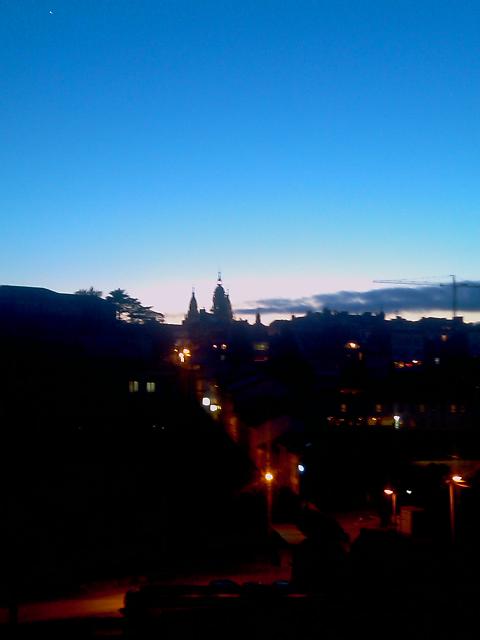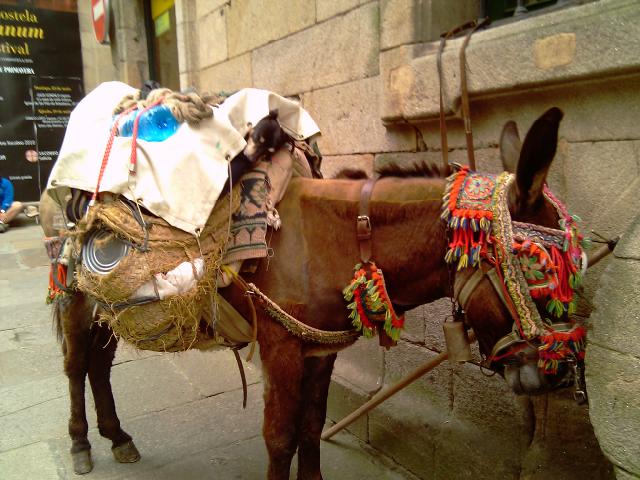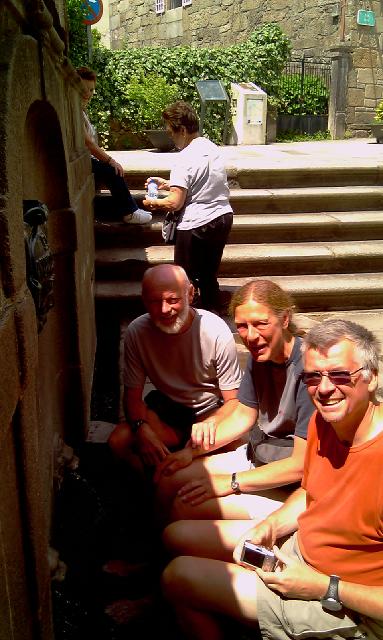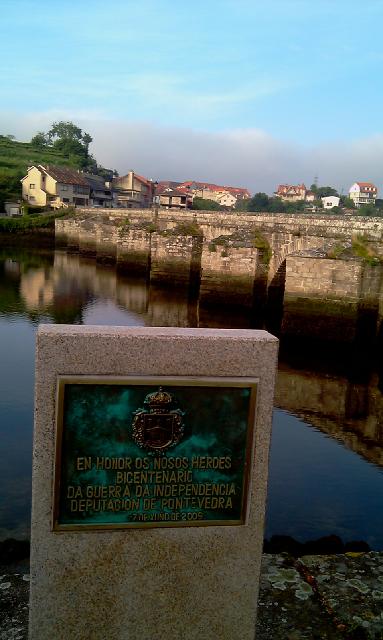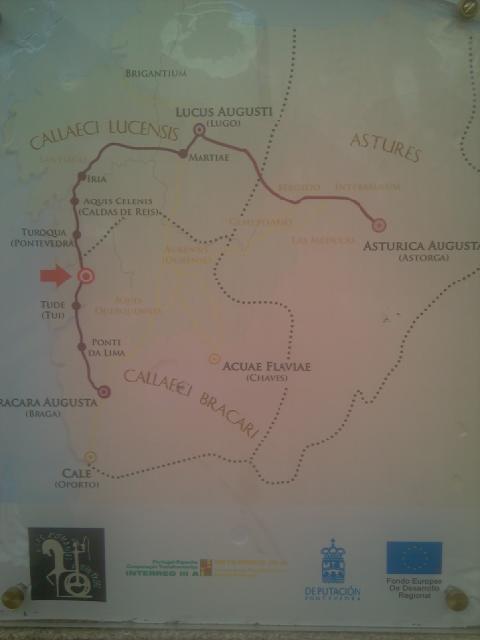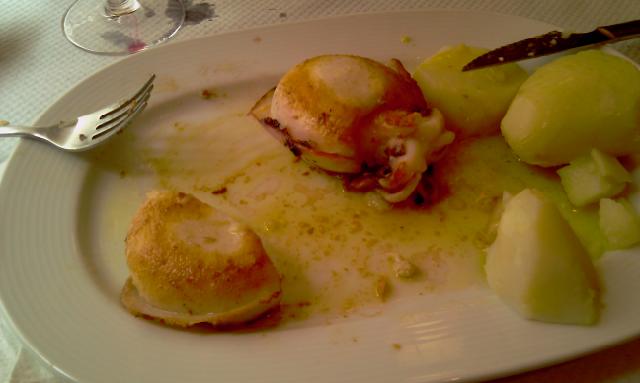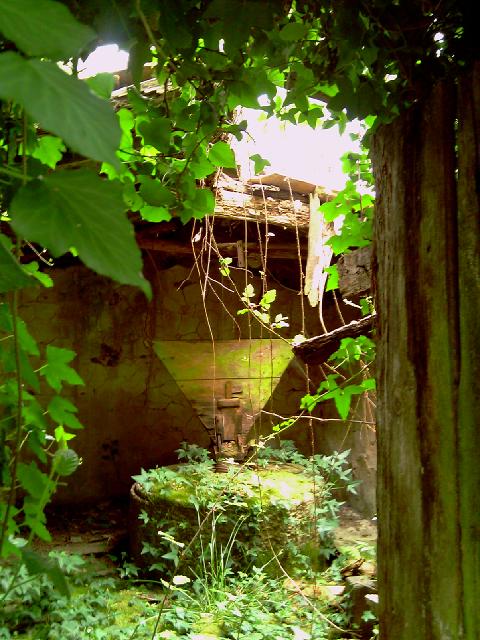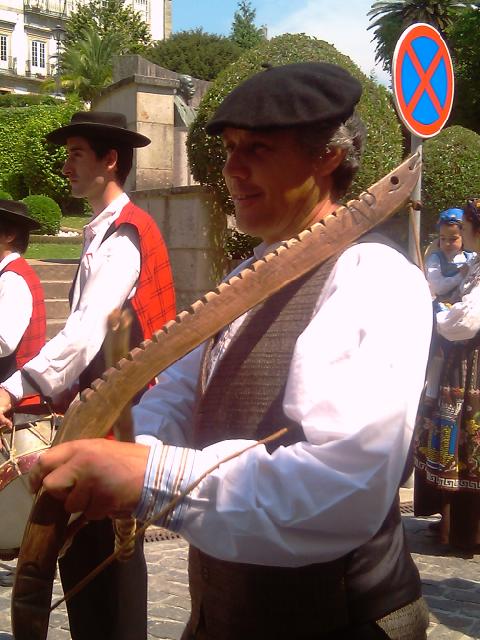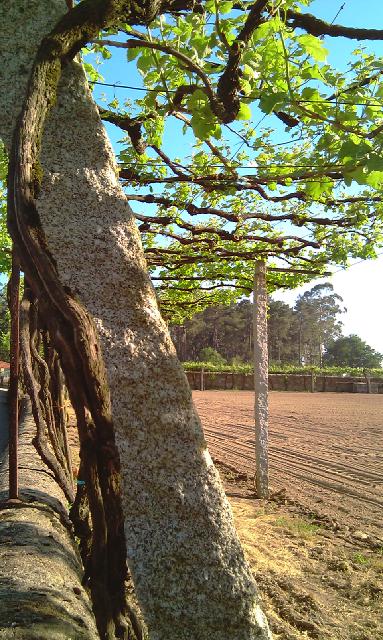May 31 Monday.
We met up with our camino friends last
night outside the cathedral, we finally learnt the correct name of our spanish friend, Valerian (he had been trying to explain it was Roman). He told us it was possible to do a tour of the cathedral roof (guided in spanish) and we tried to book it today in the cathedral museum to the left of the main entrance. Unfortunately it was fully booked for today, maybe next time. Another useful piece of information we learnt from Guido our Italian friend, alas too late, is the pilgrim rail card (20% discount) available from the desk just by the office issuing our compostellas.
We had checked into an albergue in Santiago in an old seminary just by the Parc Belvis, this is a huge stone built building which claims 100 beds but must have at least 300 spaces. It was comfortable and quiet, except for the snores of contented, completed, compostellaed pilgrims. (Tim was blissfully snoring and unaware of the elderly lady who, presumably confused by the long row of 24 beds in near darkness, tried to climb into bed first with Betsy and then with Tony!)
We now travel gradually back to Porto For a fee days recovery before travelling home, continuation on to Rome is not this year. .
Author: admin
Teo to Santiago de Compostela. 13km.
May 30 Sunday.
We decide that since we only have about 12km to go to Santiago we only need to start at 0700, it is not to be, the whole albergue is moving by 0500, and for a change we are last out at about 0600. We place the key in the box for post next to the door as instructed, this is opposite the Redstart’s nest under the porch with at least three hungry young being fed by the adults. The albergue is small 24+2 disabled beds and was open by the time we arrived at 1300 yesterday, but check in is not until 20-2100hrs.
The route twists and turns trying to stay out of built up areas but with little success and soon we reach the top of a minor hill and get a misty view of Santiago cathedral or was it a pair of fir trees? Soon after we get our morning coffee and croissant in a cafe in the suburbs and by 0930 we are queueing with many others including some seen along the way, to get our Compostella or certificate of completion (or forgiveness of sins). After this we spot a donkey outside laden with pilgrim baggage and soon his owner joins him – we don’t know how far they have travelled together.
We then queue again to enter the cathedral by the pilgrims’ door at the back, (only open during Holy Year) we expect to enter the whole cathedral by this route and wander round as two years ago. Alas no, this is Holy Year and Sunday, maximum crowd control is on and we are efficiently routed past the statue of St James for a ritual hug and then St. James’ relics (that we visited before) and outside again almost before we realise what is happening. We get a brief view from behind the altar of a mass in progress with the massive censer lit with candles, scant reward we feel for our 612km!
While on the subject of miles walked Tony would like to report a fierce rearguard action has won the battle of the boots (the boots have split), they will be disposed of forthwith.
We are very pleased to bump into a number of people we have met along the way including 3 Germans last seen in Portugal on May 11, Roma (the very friendly and helpful Spaniard, sadly almost impossible to communicate with), and Guido (the Italian) and exchange congratulatory hugs for successful completion of the camino. We arrange to meet Guido by the cathedral later for a celebratory drink. So far sadly we have failed to meet up again with Lyn, the Australian lady, Philippe the Francais, nor the Spanish couple we have nicknamed the tattoo twins.
There may or may not be further posts.
Caldas de Reis to Teo. 30km.
May 29th Saturday.
After indulgence in the hot foot pool yesterday and observing the locals coming collect supplies, (for drinking or bathing babies?) our feet are in fine form and even starting just before seven we race across the countryside on a grit walkway following the route of the good old XIX. It is raining (a 30% chance) and we find half the night’s albergue occupants sheltering in the first cafe we come to. We have been walking daily for 24 days and our legs and feet are mostly sorted although Tony’s boots seem to have won the battle of blisters, (this may be a pyrric victory, a bin is in their future), we are in contrast to those starting around Tui on the border (the minimum 100km required for a compostella) many of whom are limping and in obvious difficulty. We are accosted by the camino police at a junction (aka Proteccion Civil) who are conducting a census and give us a stamp for our credencial. They appear to be expecting a girl behind us who is limping heavily. The going is easy and we rapidly reach Padron our possible destination. In the church here is the alleged relic that started it all – under the altar is the mooring stone (el padron, from which the town got its name) that the boat bearing the corpse of St James after his beheading in the Holy Land tied up at. Also in the church is a very good Mutamoros (or representation of St James in his warlike aspect while expelling the Moors from Spain). It is 1100 so we decide to go on to the albergue at Teo, this is only 13km from Santiago and should give us time to indulge in revisiting our favorite places. We are also hoping that the ritual of swinging the botofumeiro may take place at the noon Sunday service in the cathedral.
The way from Padron to Teo is mainly on delightful back lanes that wind their way between the small houses and vineyards of numerous hamlets before depositing us at the small (24 beds), modern albergue.
Pontevedra to Caldas de Reis. 22km.
May 28th Friday.
We set off early again, it’s becoming a habit, it might be warm. In fact it is a perfect day for walking cool and bit misty until the sun gets up, but staying cool until we arrive on the edge of Caldas de Reis. On the way after retracing our steps of last night to the Sanctuario de Pelegrina in the middle of Pontevedra in the dark we follow the little blue lights in the steet stones through the maze of small streets to the edge of town where the yellow arrows take over, (we do like a town that thinks about its pilgrims).
The route follows our friend the Via Romana XIX, past ever increasing numbers of fountains and crosses, along bits of very degraded roman road and through fields and vineyards. This is a prosperous looking area there are very few derelict places and many are obviously in process of repair and most cultivatable areas are well tended, especially the vineyards in process of being sprayed against disease. We benefit from this diligence later with a very good local wine from nearby Orouense at lunchtime. Also we note a new agricultural practice, that of tethering one sheep of a small group to keep all the group in one place without fences.
During the walk we make a short 500m detour to a local beauty spot just off the N 550, a series of water mills on waterfalls. The area was used for the purpose for centuries and kept clean by the man from the local council who comes round to clean up and empty the bins. At this spot in the valley of the Rio Barosa an attack on Marshal Soult, Napoleon’s general in spain took place killing 30 of his bodyguard. This place was recommended by a spaniard who we keep meeting around various towns and albergues and is a great stop to visit on the Way.
By 1230 we arrive in Caldas de Reis over the bridge on the N 550 which claims to be a bit roman (but isn’t) and gives rise to a minor dispute as to where the albergue is (it is over the next bridge a classic old roman construction refurbished in the 17thC). On the way, down a few steps on the left in front of the hotel on the main square is a public foot bath of hot thermal sulphurous spring water. It is as hot as can be borne and is a tonic to tired pilgrim feet. We visit it after lunch and inveigle several other pilgrims into its soothing waters.
This is a very nice little town, possibly the best on the Camino Portuguesa. We have lunch with the friendly spainiard who speaks no english, Betsy is hard pressed for conversation but strikes out gamely, he manages to get over the concept of “taxigrinos” those peligrinos who use local taxis to transport their luggage or themselves up the Camino. This is a remarkable linguistic feat and we applauded him.
Redodela to Pontevedra. 17km.
May 27 Thursday.
Only four easy days remain till Santiago, so we rise late and are off just before 0700. It is misty, a typical Galician morning – cool and moist, no rain, perfect walking. We wend our way out of town yesterday’s washing decorating our packs. The albergue in Redondela while a nice old stone building is tight on space and drying clothes is impossible.
The walk includes two short but steep ascents and after the first descent there is the remains of a roman bridge that finally fell in the stream a few years ago, there are obvious plans for a replacement modern footbridge but currently a short diversion by the road is recommended (there are some home made stepping stones but a paddle in dry weather is also possible). Slightly later in Arcade there is a long narrow road bridge Pont Sampaio over which a battle was fought by Spanish army and Galicia irregular forces against Marshal Ney during the Peninsular War (Or war of independence as the spanish call it) against Napoleon. Two hundred year celebrations were recently held, (no mention of Wellington and the British of course).
Up another hill and down again where there is a welcome stop in some enterprising lady’s garden for coffee, we meet an anglo irish group who walk together on an annual basis and were impressed by our trip from Lisbon and even more by the Camino from England in 2008.
We are now well into Camino memorabilia with statues and crosses (both ancient and modern) at what seems like every step of the route.
We arrive in Pontevedra to find the albergue is open at 1pm despite being advertised as opening at 5pm. Result!
After lunch and a siesta, down into town to view the church sanctuario da perigrinaga which had a floor plan of a scallop shell. This is a pleasant town with modern shops and a nice old part of squares and bars, and lots more crosses and scallop shells.
Finally we drop into a bar for some Zamburinas (scallop in garlic) before the walk back the albergue. Another day on the Camino completed.
Tui to Redodela 30km.
May 26th Wednesday.
A long day today, so we are out of the albergue (with our paper sheets in the bin provided) by 0600. Spanish time is one hour before portuguese, so it is dark and our head torches are needed to spot the yellow arrows leading down the narrow streets to the farmlands below. It is cloudy so the light only improves slowly, rain threatens all morning but never really gets heavy. We pass though some pleasant country lanes with several ancient bridges and stone crosses, in part following the Via Romana XIX as yesterday up the valley of the Rio Loura a pleasant little stream. One of the bridges is called the Bridge of Fevers and near it is a memorial to Saint Elmo who died of a fever at this spot on returning from a pilgrimage to Santiago in 1251. ,There s an side alter dedicated to him in the cathedral in Tui.
The way marks lead us up a new path up the banks of the river but at some point we miss a turn off to the left and are corrected by advice from a lady weeding the path, up to the little albergue in a village up on the left slope of the valley. In a while we gradually descend towards Redondela stopping at a restaurant for lunch and rest, we finally arrive at the albergue in Redondela after a fairly pleasant if undemanding walk about 3.30.
The albergue is an old 16th century stone building on the Way near the middle of town. It has a good exhibition of black and white photos of the various Caminos. However the drying of washed clothes is a problem especially since we delayed washing yesterday because of the rain.
After a rest we wander round the town and try to follow the two long railway viaducts that arch over the streets below.
Outside the albergue is a map of Gallicia and Asturias with the rather circuitous route of the Via Romana XIX marked upon it. We realise that we have met it before in Astorga and Santiago on Tony and Tim’s previous Camino.
Rubiaes to Tui 18km.
May 25th. Tuesday.
Another light day, but without the hill, however the forecast is for rain. It starts at 4am (Betsy says by 00:00), by 6.30 it has stopped. 100m down the road it starts again we put waterproofs on, it stops. This game continues all morning as we progress across pleasant fields and woods with a few old (roman)bridges and parts of the Via Romana XIX (a roman main road). Betsy spots a salamander out for a walk in the rain, he seems happier than most of the other locals. After a while we arrive at Valenca on the Rio Minho which is the border with Spain, this has a walled part with impressive defence walls, Tim seems to remember there was a battle during Wellington’s peninsular campaign but he’s probably wrong. We enter a small but well defensible gate and the skies open a good excuse for a beer. After we pass – the roman milestone dedicated to Claudius and find with some difficulty the steps down to the two level bridge (railway on top, road below). And so pass to Spain.
We find our first Spanish albergue which is already open at 2pm despite the book saying that it wouldn’t be open until 5pm. check in and go for a superb lunch, starter, more main course than you can eat, pudding and wine. all for just 8€. A brief siesta followed lunch, then a visit to the cathedral seemed essential. We admired the cloisters during a downpour that made the gargoyles earn their keep. The view from the tower was good despite the weather and we were reminded of the general Spanish disregard for health and safety while walking around the tower top with no protective railings!
This evening we meet Lyn the Australian and have a pleasant evening im a bar with s jug of Vinho mucho collapso.
Ponte do Lima to Rubiaes. 17km
May 24th Monday. Segunda-feira.
We left the very excellent albergue in Ponte do Lima slightly later at 0630 due to a day planned as slightly shorter than yesterday. We also hope the weather forecast is accurate and the cool cloudy day forecast is accurate because we have a 400m ascent to do. In the event after 10km through fields of crops and vines we have had a touch of rain and it is cloudy and cool. The collapsed bridge mentioned in several accounts and of concern to Lyn an Australian also walking from Porto, has been replaced by two immense steel girders, not pretty but should last a few centurys. On the way we have met a lovely couple cutting hay and forking it on to an ancient wooden cart pulled by a docile cow, he sees us taking pictures and stops the strimmer (alas not a scythe) and gets Tim to hold her lead rope for photos. We add a slow worm to the witch’s collection of roadkill.
The ascent in the event is not bad through pine and eucalyptus forest and down again passing old stone crosses, springs and an old mill with three buildings and a few old millstones, it was apparently a maize mill making flour for broa, the local bread. Later in the little shop in the village of Rubiaes we see for sale a small maize stripping machine looking like a large bean slicer – we needed to inquire of the man running the shop what it was and then decline to buy it on grounds of weight (it was cast iron).
The albergue appeared on the path in the strung out village on the side of the valley we descended into just after the 13th C romanesque church. The albergue was open at 11.30 when we arrived but with no guardian so we signed ourselves in and he arrived later no problems (it is supposed to open at one) and is well equipped and clean.
Barcelos to Ponte do Lima. 32km.
May 23rd Sunday, Domingo.
Today is a big day according to the guide book, so we start early and are out and walking by 0530. We had a good night’s sleep, we were at the back of the residencial but by others’ accounts things did not get too heavy or late.
This is a very pleasant days walking and not quite as long as most accounts, it is mostly large rock paving or cobbles with some dirt tracks. The two ascents are neither long or arduous and the countryside is pleasant and well cultivated with the vines round the edge of the fields even more in evidence than yesterday. The new Portela albergue is functional and opens at four pm, we did not stay there but it looked good from the outside. The only hazard encountered was a near collision with a bunch of cyclists on the dirt track descent from Forcada, they were enjoying themselves. The bar arrived as promised in Corva on the main road. We soon left this and bowled along the flood plain into Ponte da Lima finally entering town along the river through the long line of ancient plane trees under which the fortnightly market takes place (reputedly oldest market in portugal).
In town this afternoon, we see a procession of locals in national costume. There are numerous little bands consisting of accordion player, ukelele, washboards, serrated bits of wood and stick, castanets, triangles and other stuff. A great sound was made.
All were in local costume and carrying local arts and craft. A great display of local tradition. I don’t think that we would be able to put on such a display back on the UK.
Vilarinho to Barcelos. 27km.
May 22nd Saturday.
We slept ok in the little albergue joined by Guido an Italian and Patricia a Swede, Tim who had been considering sleeping outside due to the heat, was thus able to portray himself as a gentleman and give up his bed as there were only four.
Bedtime was perhaps a little later than we would have wished owing to half the village turning out for a ladies five a side football match on the all weather pitch in our little bit of school grounds.
Still the next day dawned and we set off on a much better day’s walking than yesterday. Only one or two lorries too big for the road they were on passed us before we were off into rural portugal again on a mix of cobbled side roads and large granite boulder old ways. The country here is more prosperous looking with few abandoned buildings and well tended fields with little untilled ground. Many of the fields have stone supports for vines built into the old stone walls. We think this arrangement both made good use of available land and provided shade at the sides for field labourers, a reason we find increasingly likely as the day heats up to 33deg C with little wind. We cross a couple of old bridges may be originally roman, who knows? One with a chap off with a pitchfork, presumably to turn the hay in the fields. The gardens seem to contain fewer semi-tropical looking plants, but the roadkill remains interesting with a mole, a toad and another snake added to the already extensive list.
Around 12km or so after starting we reach Rates a town obviously proud of its ancient past, its church while now largely Romanesque and therefore only 12th century replaced one much older and probably an original roman site of worship (which gods are not specified).
Eventually and with much effort in the heat we reach Barcelos having passed most people we saw on the way as they dropped out into barious bars to escape the heat.
Barcelos centre is a nice old medieval town with a bridge over the significant Rio Cavado and a legend about a pilgrim who was saved from hanging by a cockerel who crowed after being cooked. This “miracle” is suspiciously like the legend of the white cock and hen in Santo Domingo on the Camino Frances so probably in the murky past of Iberia there is an element of truth, but who knows. The town is full of effigies of cockerels (mostly modern and plastic) and is in the middle of preparing for a festival. We get a room in the back of the Residential Arantes (the front is 20m from the speakers for tonights performance) right by the Temple of Good Jesus on the main square. We also get a good lunch for 5euros each including vinho, at Restaurant Patrique just round the corner. The square is now a scene! Live music at high volume but as yet 2030 not a huge audience maybe the main bands start at midnight, ah well we are at the back.
